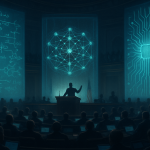It’s November 17th, 2025, and the AI world just got a whole lot buzzier. OpenAI, never one to rest on its laurels, has dropped GPT-5.1, an amped-up version of its already impressive GPT-5 model. Remember when GPT-3 felt like magic? Now, GPT-5.1 is here to make GPT-3 look like a pocket calculator. This isn’t just a minor version bump; it’s a significant leap forward, promising smarter conversations, personalized interactions, and a whole new level of AI integration.
The release comes at a pivotal moment. For years, we’ve been edging closer to a truly seamless AI experience, one where the technology fades into the background and becomes an intuitive extension of our own minds. Think Samantha from “Her,” but, hopefully, with fewer existential crises. GPT-5.1 seems poised to push us even further down that path.
But what exactly makes GPT-5.1 so special? Let’s dive into the details.
OpenAI is touting improvements across the board: intelligence, conversational abilities, and user customization. They’ve rolled out two main flavors of the model: “Instant” and “Thinking.” Imagine “Instant” as your quick-witted friend who always has a snappy answer, perfect for rapid-fire brainstorming or getting information on the fly. “Thinking,” on the other hand, is the contemplative sage, capable of deep reasoning and complex problem-solving. It’s the AI you’d want by your side when tackling a thorny philosophical debate or designing the next generation of fusion reactors.
The real game-changer, however, might be the refined reasoning capabilities. We’re talking about AI that can not only understand what you’re saying but also why you’re saying it. It’s the difference between a parrot repeating words and a therapist offering insightful feedback. This enhanced understanding leads to more contextually appropriate interactions, meaning less AI-induced frustration and more genuine collaboration.
And then there’s the customization. Remember those early days of AI chatbots that sounded like robotic drones? GPT-5.1 lets you personalize the model’s tone. Want a conversational AI that sounds like a friendly librarian? Done. Need a digital assistant with the gravitas of Morgan Freeman? You got it. This level of control allows for a truly tailored experience, making AI interactions feel more natural and less…well, robotic.
For now, access to GPT-5.1 is limited to paid users and available via API. This means developers are the first in line to experiment with these advanced features, weaving them into their own applications. Expect to see a wave of innovative AI-powered tools hitting the market in the coming months, from smarter customer service bots to AI-driven writing assistants that can actually understand your creative vision.
But with great power comes great responsibility, as Uncle Ben famously said. The release of GPT-5.1 raises some serious questions about the future of AI. Are we ready for AI that can mimic human conversation so convincingly? What are the implications for misinformation and deepfakes? And how do we ensure that these powerful tools are used for good, not for ill?
The ethical considerations are significant. As AI becomes more sophisticated, it’s crucial that we have robust safeguards in place to prevent misuse. We need to be vigilant about bias in algorithms, protect against the spread of disinformation, and ensure that AI is used to augment human capabilities, not replace them entirely. The debate surrounding AI regulation is only going to intensify as models like GPT-5.1 become more prevalent.
From a financial perspective, OpenAI’s continued dominance in the AI space is undeniable. The company’s valuation is likely to skyrocket even further with the release of GPT-5.1, attracting even more investment and talent. This could lead to a consolidation of power, with OpenAI becoming an even more influential player in the tech industry. Competitors will need to innovate quickly to keep pace, or risk being left behind in the AI arms race.
The economic impact is also worth considering. GPT-5.1 has the potential to automate a wide range of tasks, from customer service to content creation. This could lead to increased productivity and efficiency, but also raise concerns about job displacement. It’s crucial that we invest in education and training programs to help workers adapt to the changing demands of the labor market.
Ultimately, the release of GPT-5.1 is a reminder that AI is not just a technology; it’s a force that’s reshaping our world. It’s up to us to guide its development responsibly, ensuring that it serves humanity’s best interests. As with any groundbreaking innovation, we must proceed with both excitement and caution, embracing the potential while mitigating the risks. The future is here, and it’s powered by AI. Let’s make sure we’re ready for it.
Discover more from Just Buzz
Subscribe to get the latest posts sent to your email.


